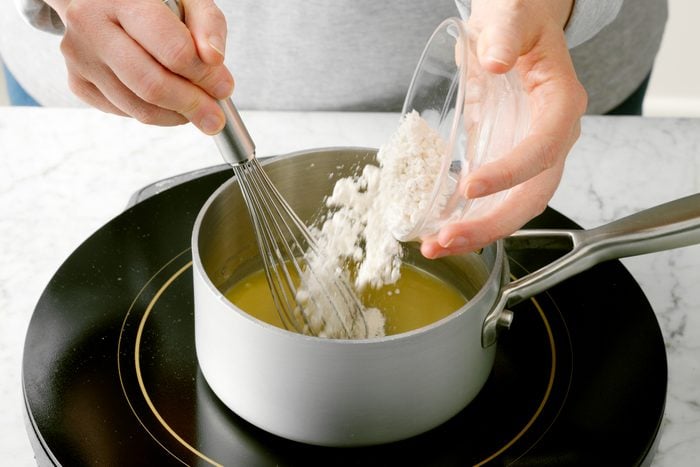In the heart of every culinary endeavor, there lies a haunting fear—the fear of oily gravy. This once-promising condiment can swiftly transform into a greasy nightmare, threatening to mar any dish it adorns. But fear not, fellow foodies, for we have embarked on a culinary odyssey to conquer this gastronomic nemesis. Let us delve into the realm of oily gravy rehabilitation, armed with expert insights, time-tested techniques, and an unwavering dedication to culinary redemption.

Image: www.tasteofhome.com
Understanding the Culprit: The Genesis of Oily Gravy
Before we embark on our oily gravy rescue mission, it’s imperative to grasp the root of the problem. Excessive oil in gravy typically arises from one of two sources: excess fat in the cooking process or an imbalance in the ratio of flour to fat.
When preparing gravy, using meats with high-fat content can contribute to an oily end result. Additionally, if insufficient flour is incorporated relative to the amount of fat present, the gravy may struggle to achieve an ideal consistency, resulting in a greasy separation.
Conquering Oily Excess: An Arsenal of Culinary Techniques
Now that we’ve identified the culprits behind oily gravy, let’s arm ourselves with an arsenal of culinary techniques to vanquish this vexing issue:
-
Flour Power: Flour acts as a thickening agent, absorbing excess fat and lending a desirable consistency to gravy. When crafting gravy, ensure an appropriate ratio of flour to fat. A general rule of thumb suggests using approximately 1 tablespoon of flour for every cup of liquid.
-
Cornstarch Intervention: Cornstarch, another thickening agent, possesses an even greater potency than flour. In cases of particularly oily gravy, cornstarch can be employed as a swift and effective solution. Dissolve 1 tablespoon of cornstarch in 2 tablespoons of cold water to form a slurry, then whisk it into the gravy. Allow it to simmer until thickened.
-
The Refrigeration Remedy: Chilling gravy before skimming provides an effective means of separating fat from the liquid. Refrigerate the gravy for several hours or overnight, allowing the fat to solidify at the surface. Once chilled, the congealed fat can be easily removed, providing a leaner and more flavorful gravy base.
-
Blotting Paper Absorption: For a quick and easy oil-removal method, blot the surface of the hot gravy with paper towels. The paper will absorb excess oil, leaving behind a cleaner and more refined gravy.
-
Fat Separator to the Rescue: If time permits, a fat separator can prove to be an invaluable tool in the oily gravy battle. This handy device utilizes gravity to separate fat from liquid, providing a convenient and efficient means of purification.
Expert Insights: Wisdom from Culinary Masters
Renowned chefs have generously shared their wisdom on the art of taming oily gravy:
-
“When making gravy, start with a flavorful stock or broth. This will provide a rich base and help to reduce greasiness.” – Chef Jacques Pépin
-
“Don’t be afraid to use a little bit of butter or oil when making gravy, but don’t overdo it. Too much fat will make the gravy greasy.” – Chef Emeril Lagasse
-
“If you find your gravy is too oily, you can skim off the excess fat with a spoon. You can also add a little bit of flour or cornstarch to help thicken the gravy and absorb the fat.” – Chef Julia Child

Image: www.pinterest.com
How To Fix Oily Gravy
Conclusion: The Triumph Over Oily Gravy
With a newfound arsenal of techniques and expert insights, you now possess the culinary prowess to vanquish oily gravy for good. Remember, the key lies in controlling fat content through proper ingredient selection and thickening agents, while employing strategic methods like refrigeration, blotting, and fat separation to further refine your gravy.
As you conquer the oily gravy challenge, embrace the newfound confidence that culinary mastery brings. Share your triumphs, inspire fellow foodies, and spread the gospel of gravy enlightenment. May your culinary adventures be forever free from the tyranny of oily excess.